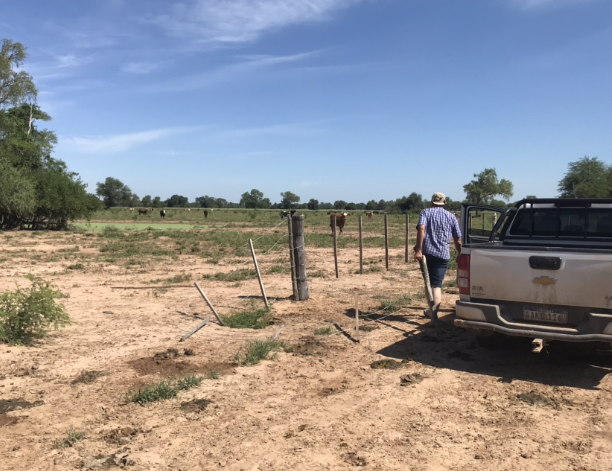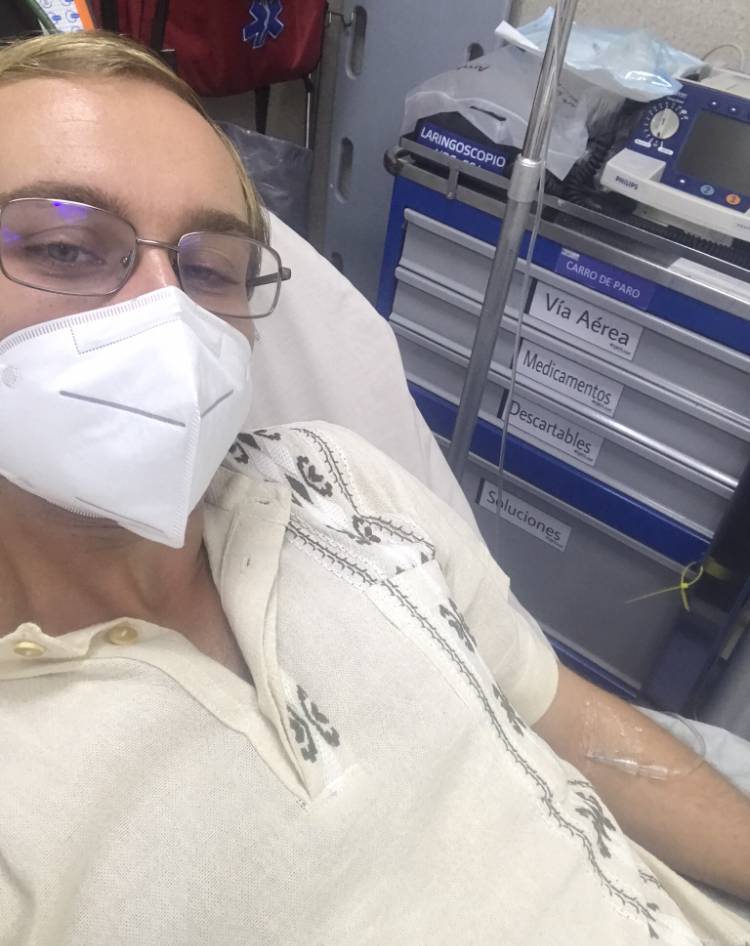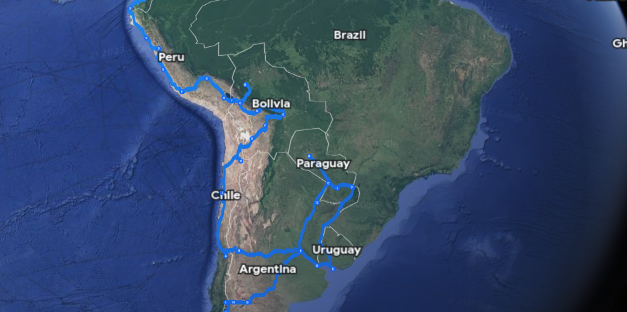If you have spent any time on my website, you know that I am someone who heeds the call of adventure. I work as an outdoor guide, do not have a permanent address, and spend most of my free time planning my next trip.
South America had long been at the top of my list of places to visit for a number of reasons. Learning Spanish had been a long-term goal of mine, so I wanted to travel to a Spanish-speaking part of the world to practice. In addition, I had always imagined South America as a continent full of beautiful landscapes and adventures waiting to be had. It certainly delivered in these regards, but I soon learned that it has a whole lot more to offer than just adventure.
General Outline
During my travels, I visited every Spanish-speaking country in South America except Venezuela. I would love to visit Venezuela someday, but I did not travel there because it was under a Do Not Travel advisory for the entirety of my trip.
I traveled from September 2022 until April 2023, on a route that took me from Bogotá, Colombia to Punta Arenas, Chile. All of my travel between those two cities was done entirely by road or by water, and along the way I traveled through Colombia, Ecuador, Peru, Bolivia, Paraguay, Argentina, Chile, and a little bit of Uruguay.
The route I took through South America.

I worked hard to make my experiences as diverse as possible. I visited large cities, rural areas, coasts, the Andes, and the Amazon. I fished for piranhas, visited large, modern cities, and even worked on a farm. Where I could, I stayed with locals that I met either through the app Couchsurfing or through mutual friends. To improve my Spanish, I went to great lengths to immerse myself among the people and culture of every place I visited.
Lessons Learned
The seven months I spent traveling across South America were some of the most trying and rewarding of my life. It is no understatement to say that it was a life-changing experience that I will be mentally unpacking for years to come. That being said, there are a few lessons that really stand out, and I will explain them below.
Learning Spanish
Like many Americans, I grew up only speaking English. I had studied Spanish for a few years in high school, but in my head, learning another language was something I thought was only possible for small children or people with a genius-level intellect. But during my travels, I learned that languages, like everything else, are just skills that anyone can build through consistent and disciplined practice.
I took a standardized Spanish proficiency test before and after starting my trip, which revealed that my Spanish level progressed from CEFR level B1 to C1. In layman’s terms, this means that I progressed from an intermediate to a near-fluent level, a jump that typically takes several years in a classroom!
But beyond the results of a language test, I experienced real, applicable improvements that made my travels much more enjoyable. Upon arriving in Colombia, I struggled to understand even basic questions and stared blankly when someone tried to talk to me. But by the end of my trip, I was telling jokes and stories over mates with Argentinians who did not speak a word of English.
The road to that level of proficiency took me through many stressful situations and literal headaches. In addition to forcing myself into situations where I had to speak Spanish, I also studied diligently. Every time I encountered a word I did not know, I added it to a list that I would study every night. After doing this for seven months, that list is over 900 words long, showing that I added nearly 1000 words to my vocabulary during my travels.
I also familiarized myself with many different accents and dialects. One thing that surprised me was just how different some accents can be. I still remember my first conversation with someone from Buenos Aires, which went something like:
Me: What was that? I didn’t quite understand. Can you talk a bit slower?
Her: Okay. Do you even speak Spanish?
Me: Yes, do you?
Even at the end of my trip, I still met the occasional person who spoke in such a way that I could not understand a single word they said. Not a single word. The differences that exist within the Spanish language are enormous, and something that even native speakers struggle with when they travel.
Traveling across South America familiarized me with many different accents, which greatly improved the versatility of my Spanish. I am now familiar with many of the regional differences, like the meaning of the word “coger,” and proper use of the word “chimba.” So next time I visit (and there will be a next time), I will be able to visit many different parts of the Spanish-speaking world with minimal difficulty understanding and being understood.
Empathy
While getting to know locals from across South America, I did not just encounter different accents and ways of speaking. I also met a lot of different kinds of people with different values and different life experiences. Meeting people ended up being one of my favorite parts of the trip, because I learned to appreciate that people can be both astonishingly similar and astonishingly different from myself.
During my hike to the top of the Sumaco Volcano in Ecuador, I spent four days climbing to volcano with my guide, José. Like me, he was a 22-year-old outdoor guide, and our similarities went much further. We had the same sense of humor and laughed at the same jokes. He was independently studying English, just as I had independently studied Spanish. He was even planning a trip to Colombia in which his top destination, the Sumapaz Páramo, was also my favorite spot in Colombia! I realized that the only real reason why we lived different lives and had different opportunities in life was that he was born in an indigenous community in Ecuador, whereas I was born in a large city in the United States. Yet in spite of coming from very different backgrounds, we shared many similarities and got along very well.
Alternatively, my time staying with a Mennonite family in Paraguay showed me just how different people can be. In the town of Filadelfia, I stayed with a German and Spanish-speaking couple to learn more about the Mennonite way of life. During my stay, I got to attend a family reunion with the husband, Rudolf, and meet his 12 brothers and sisters. I also learned about the Mennonite faith, specifically its emphasis on love and pacifism, which led Rudolf’s parents to leave everything behind and move from Russia to rural Paraguay to escape military service. Yet because of and in spite of our differences, I feel we were able to connect with and learn a lot from each other.
Going with Rudolf to take help care of his cows.

I had experiences like these throughout my time in South America. They showed me that while cultures and ways of life can differ greatly, most people, regardless of where they come from, have a lot in common. This realization helped me learn to connect with people on a much deeper level and reach across our differences in background.
Minimalism
At every point during my trip, I had to make sure that my belongings were few enough to fit in a single backpack. At the same time, I traveled to many rural areas where I had to be 100% self-sufficient. This forced me to constantly evaluate and re-evaluate what I carried with me. And as I evaluated and talked to other travelers about what they carried, I realized that, counterintuitively, those who were traveling for the longest often had the smallest backpacks.
This was something I had noticed not just traveling through South America, but also as a wilderness backpacker in the United States. I believe this happens because long-term travelers understand just how few possessions we need to be happy and comfortable. Personally, I found my pack growing smaller over the course of my trip as I learned what I did not need.
In addition, traveling light carries a number of advantages. Just a few of them include being cheaper, making carrying your bag less strenuous, making you less likely to lose things, and allowing you to save time packing and unpacking.
Most importantly, traveling light teaches us a fundamental lesson about life: that the people we meet and the experiences we have are far more important than the things we own. Minimalism is just an extension of this idea because it allows us to spend less time worrying about our things so that we can spend more time experiencing the world
You can see the packing list I created after 7 months of traveling here.
Staying Healthy
During my seven months of travel, I got sick with a fever four different times. I had strep throat, severe traveler’s diarrhea, an unidentified disease that was probably dengue fever, and chikungunya, a relative of dengue. Being sick so many times came as a great surprise to me, especially because I get sick once a year or less during my normal life.
Getting treated for chikungunya in a Paraguayan medical clinic.

Traveling, not surprisingly, is perhaps the best way to get sick. Traveling:
- Exposes you to new germs from all around the world.
- Puts you into contact with an ever-changing group of strangers.
- Weakens your immune system by subjecting you to constant stress from constantly changing surroundings
- Makes maintaining habits like regular exercise, healthy eating, and a regular sleep schedule difficult, if not impossible.
And since I started my trip unprepared to deal with these changes, I got sick four different times. But experience is the best teacher, so by the end of my trip I had made some changes to keep this from happening in the future. I started
- Keeping hand sanitizer with me at all times and using it regularly.
- Wearing masks in crowded public spaces.
- Limiting the amount of time I spent in crowded hostel rooms and making sure to keep my distance from anyone who had the sniffles.
- Avoiding street food, no matter how delicious it smelled. Food from restaurants and markets never gave me issues.
- Making a conscious effort to avoid mosquitoes by staying inside during peak mosquito hours, using bug repellant, and wearing long sleeves and pants.
- Above all, setting aside time to relax and recover from the stresses of traveling.
Backpacking, which I define as the style of travel where people travel for an extended period of time and travel quickly from place to place, is really exhausting. For all of the reasons I outlined above, it is both physically and mentally straining in so many ways.
It has a lot of benefits, too. It is a lot of fun and allows you to visit many places relatively cheaply, and puts you in contact with lots of other travelers. But for me, the experience was too draining for me to want to backpack for a long period of time again.
But that does not mean that I am done traveling. Backpacking is just one of a nearly infinite number of ways to see the world. You can also travel to:
- Work or volunteer
- Study at a foreign university
- Take a language course
- Take part in a cultural exchange program
Next time I travel, I will pursue one of these options. I had a wonderful time backpacking across South America, and now I want to experience developing deeper ties to one place by traveling in a different way.
